Barcelona Demos and Motherboards
Much to our dismay and definitely against our recommendations, AMD will not follow in Intel's footsteps and let us do a performance preview of Agena or Barcelona. In fact, AMD wouldn't even let us know what clock speeds its demo systems were running at. While we cautioned AMD that a lack of information disclosure at this point would only reinforce this idea that AMD is lagging far behind Intel, AMD's counterpoint does have some validity. AMD's reasoning for not disclosing more information today has to do with not wanting to show all of its cards up front, and to give Intel the opportunity to react. We still don't believe it's the right decision, and we can't help but believe that the reason for not disclosing performance today is because performance isn't where it needs to be, but only AMD knows for sure at this point.
In order to combat worries that Barcelona is fundamentally broken, AMD did give us a couple of live demos of an 8-core QuadFX system and a 4-core Socket-AM2+ system. AMD ran Cinebench as well as Nero Recode on the systems, but it did not let us measure performance on either. Both systems worked fine; they didn't get too hot and they didn't crash.
Undoubtedly Agena and Agena FX work. We suspect that clock speeds aren't quite as high as they need to be but we don't doubt that AMD can get there by its scheduled release sometime in the second half of this year.
AMD also let us get up close and personal with the motherboards used in these systems, but we can't disclose details about the chipsets used just yet. Keep in mind that what you're looking at is AMD's next-generation desktop chipset solution.
The Hammerhead reference board is AMD's Socket-AM2+ reference board that was used in the quad-core Agena system above:
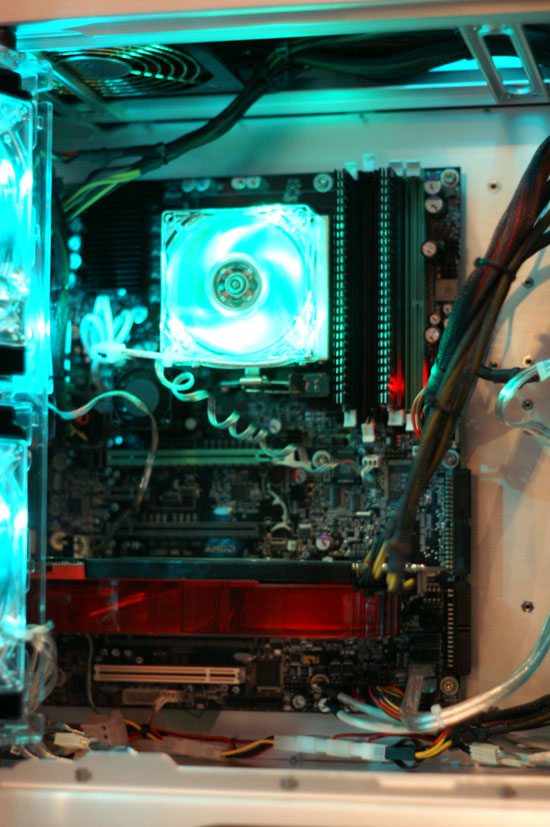
Up and running
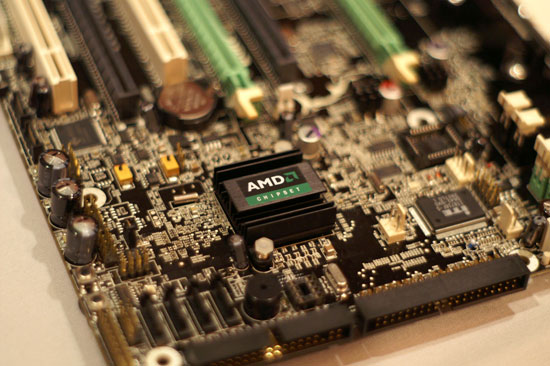
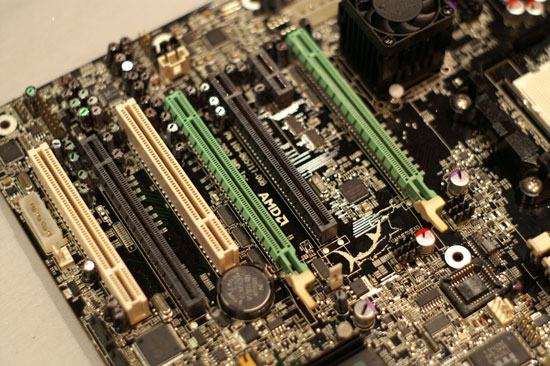
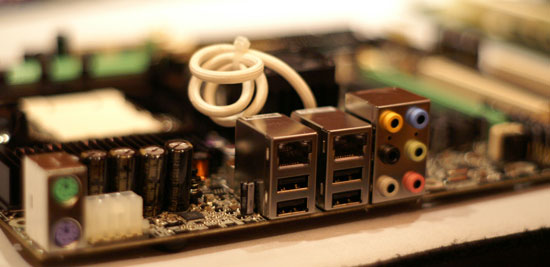
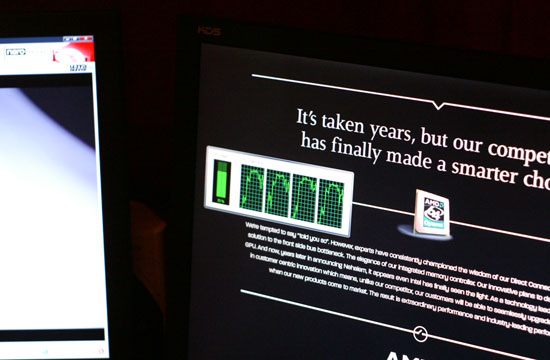
All four cores, loaded and running
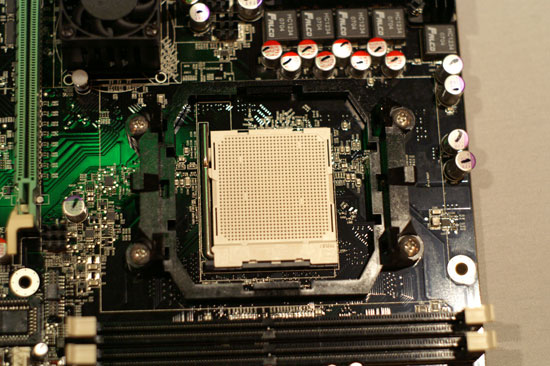
Socket-AM2+
The Wahoo reference board is AMD's QuadFX Socket-1207+ reference board, used in the eight-core Agena FX system:
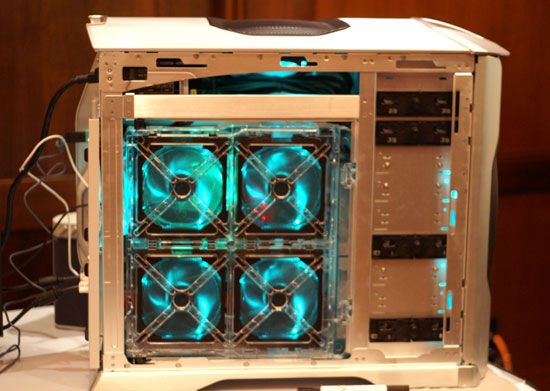

Quad core per socket x two sockets
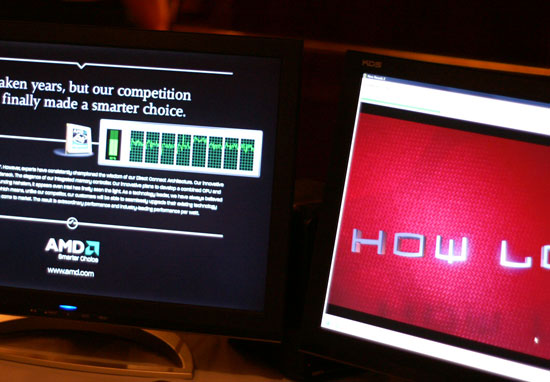
All eight cores, locked and loaded
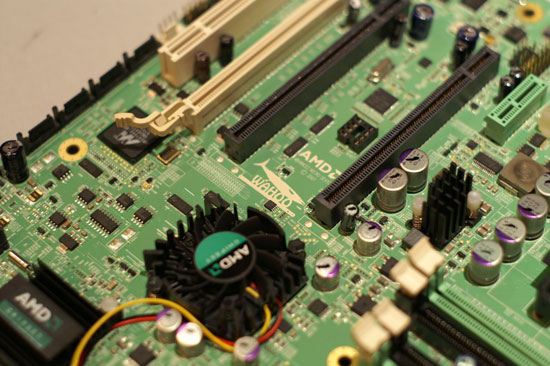
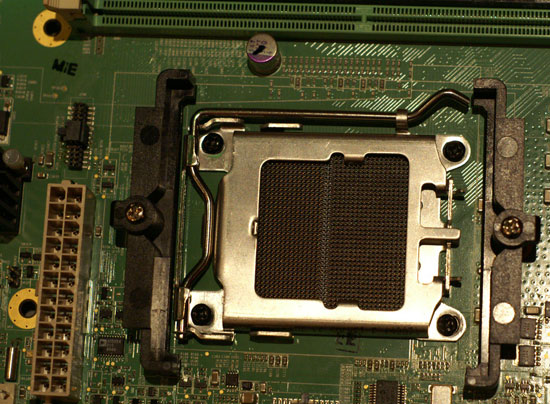
Socket-1207+
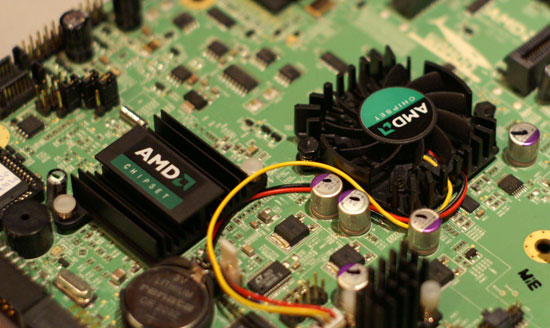
And here's the man that made sure we could see these demos - AMD's Ian McNaughton:

He's also the guy that prevented us from running benchmarks, and hid the Cinebench scores from us:

Much to our dismay and definitely against our recommendations, AMD will not follow in Intel's footsteps and let us do a performance preview of Agena or Barcelona. In fact, AMD wouldn't even let us know what clock speeds its demo systems were running at. While we cautioned AMD that a lack of information disclosure at this point would only reinforce this idea that AMD is lagging far behind Intel, AMD's counterpoint does have some validity. AMD's reasoning for not disclosing more information today has to do with not wanting to show all of its cards up front, and to give Intel the opportunity to react. We still don't believe it's the right decision, and we can't help but believe that the reason for not disclosing performance today is because performance isn't where it needs to be, but only AMD knows for sure at this point.
In order to combat worries that Barcelona is fundamentally broken, AMD did give us a couple of live demos of an 8-core QuadFX system and a 4-core Socket-AM2+ system. AMD ran Cinebench as well as Nero Recode on the systems, but it did not let us measure performance on either. Both systems worked fine; they didn't get too hot and they didn't crash.
Undoubtedly Agena and Agena FX work. We suspect that clock speeds aren't quite as high as they need to be but we don't doubt that AMD can get there by its scheduled release sometime in the second half of this year.
AMD also let us get up close and personal with the motherboards used in these systems, but we can't disclose details about the chipsets used just yet. Keep in mind that what you're looking at is AMD's next-generation desktop chipset solution.
The Hammerhead reference board is AMD's Socket-AM2+ reference board that was used in the quad-core Agena system above:

Up and running
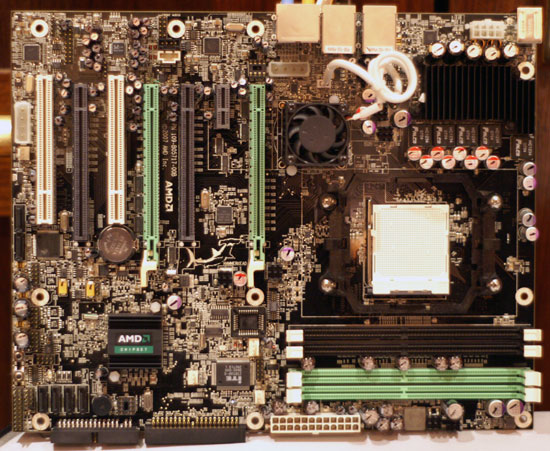 |
| The motherboard - Click to Enlarge |




All four cores, loaded and running

Socket-AM2+
The Wahoo reference board is AMD's QuadFX Socket-1207+ reference board, used in the eight-core Agena FX system:


Quad core per socket x two sockets

All eight cores, locked and loaded
 |
| The Wahoo Motherboard - Click to Enlarge |


Socket-1207+

And here's the man that made sure we could see these demos - AMD's Ian McNaughton:

He's also the guy that prevented us from running benchmarks, and hid the Cinebench scores from us:











55 Comments
View All Comments
TA152H - Friday, May 11, 2007 - link
Actually, I do have an idea on what AMD had to do with it. You don't. If you know anyone from Microsoft, ask about it.Even publicly, AMD admitted that Microsoft co-developed it with them.
By the way, when was the last time you used AMD software? Do you have any idea what you're talking about, or just an angry simpleton?
rADo2 - Friday, May 11, 2007 - link
Oh man, AMD copied, in fact, all Intel patents, due to their "exchange". They copied x86 instruction set, SSE, SSE2, SSE3, and many others. Intel was the first to come up with 64-bit Itanium.And AMD is/was damn expensive, while it had a window of opportunity. My most expensive CPU ever bought was AMD X2 4400+ ;-)
fic2 - Friday, May 11, 2007 - link
What does the 64-bit Itanium have to do with x86. Totally different instruction set.And what would the Intel equivalent to your X2 4400+ have cost you at the time? Or was there even an Intel equivalent.
rADo2 - Friday, May 11, 2007 - link
"What does the 64-bit Itanium have to do with x86" -- Intel had 64-bit CPU way before AMD, a true new platform. AMD came up with primitive AMD64 extension, which was not innovative at all, they just doubled registry and added some more.yyrkoon - Friday, May 11, 2007 - link
You mean - A 'primitive' 64BIT CPU that outpeformed the Intel CPU in just about every 32BIT application out there. This was also one reason why AMD took the lead for a few years . . .fitten - Friday, May 11, 2007 - link
It was actually pretty smart on AMD's part. Intel was trying to lever everyone off of x86 for a variety of reasons. AMD knew that lots of folks didn't like that so they designed x86-64 and marketed it. Of course people would rather be backwards compatible fully, which is why AMD was successful with it and Intel had to copy it to still compete. So... it's AMD's fault we can't get rid of the x86 albatross again ;)TA152H - Friday, May 11, 2007 - link
AMD had no choice but to go the way they did, there was nothing smart about it. They lacked the market power to introduce a new instruction set, as well as the software capability to make it a viable platform.Intel didn't even have the marketing muscle to make it an unqualified success. x86 is bigger than both of them. It's sad.
rADo2 - Friday, May 11, 2007 - link
I bought X2 because I wanted NVIDIA SLI (2x6800, 2x7800, 2x7900, etc.) with dualcore, so Pentium D was not an option (NVIDIA chipsets for Intel are even worse than for AMD, if that is possible).X2 was more expensive than my current quadcore, Q6600, and performed really BAD in all things except games.
I hated that CPU, while paying about $850 (including VAT) for it. For audio and video processing, it was a horrible CPU, worse than my previous P4 Northwood with HT, bought for $100, not to mention unstable NVIDIA nForce4 boards, SATA problems, NVIDIA firewall problems, etc.
I never want to see AMD again. Intel CPU + Intel chipset = pure godness.
yyrkoon - Friday, May 11, 2007 - link
SO, by your logic, just because a product does not meet your 'standard' ( which by the way seem to be based on 'un-logic' ), you would like to see a company, that you do not like, go under, and thus rendering the company that you hold so dearly in your mind, a monopoly.Pray AMD never goes under, because if they do go away, your next system may cost you 5x as much, and may perform 5x worse, and there will be nothing you can do about it.
Cheers
TA152H - Friday, May 11, 2007 - link
Not only that, but HP had more to do with the design than Intel.